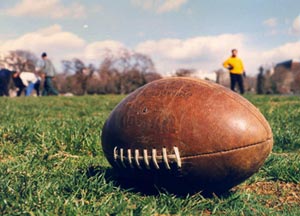Superbowl science 2012

 Today in America is our most revered holiday: the Superbowl. I am not particularly invested in either team -- I had to look up who's playing, to be honest -- but there is something about the game I like: science! Yes, science, of which there is plenty to be had during any sporting event. You just have to look for it.
Today in America is our most revered holiday: the Superbowl. I am not particularly invested in either team -- I had to look up who's playing, to be honest -- but there is something about the game I like: science! Yes, science, of which there is plenty to be had during any sporting event. You just have to look for it.
Last year, during the big game, I tweeted a series of science facts relating to football, and, when the game was over, collected them into a blog post.
I thought it would be fun do it again -- this time, I'll use the hashtag #Sciperbowl -- but this year, instead of waiting to collect them, I'll simply update this post as I add them. That way you don't have to wait until the end of the game to see them all.
So sit back on your recliner, keep one hand in a bag of chips and another on the refresh button. Let's see how to really enjoy this game! I'll start the tweets and start updating this post at the start of the game.
First Quarter
1) Realistically, a football is not a ball. It's more of a prolate spheroid.
2) Football pads work by absorbing impact as well as spreading it out over a larger area.
3) Pads lower the force of impact by lengthening the time of the collision.
4) Pressure = Force/Area, so increasing the area of the impact reduces pressure and therefore injury.
5) Every time a football is thrown, it's briefly in orbit... but the Earth gets in the way.
Second Quarter
NOTE: The following info uses air (not ground) speed and neglects air resistance. [Note: the math on these next ones can be found online, for example at the CSU San Bernadino website.]
6) To be thrown 100 yards, a football should leave the quarterback's hand at a 45 degree angle at 70 mph.
7) The ground speed of that throw is about 50 mph.
8) A ball thrown like that will reach a max height of about 80 feet.
9) A 100 yard throw like that will take about 4.5 seconds to go up and come back down.
Halftime
10) Halftime for the Universe was 6.86 billion years ago (+/- .12 billion).
Third Quarter
11) Because the Moon has 1/6 the Earth's gravity, lunar football would be pretty different.
12) On the Moon, a football thrown at 70 mph would go 600 yards, take 27 seconds, and reach 500 feet high.
13) Throw a lunar football at 28 mph to get it 100 yards downfield. It'll take 11 seconds & get 80 feet high.
14) All those throws assumed a 45 degree angle. At higher and lower angles, the ball must be thrown faster.
15) Want the ball to go into Earth orbit? You'll have to throw it at 5 miles per second.
16) In a black hole, it doesn't matter how hard you throw the ball. It's not getting out.
Fourth Quarter
17) During a 4 hour game, the Earth rotates 60 degrees.
18) During a 4 hour game, the Earth spins a total of 3200 miles at the latitude of Indianapolis.
19) During a 4 hour game, the Moon travels over 9000 miles around the Earth.
20) During a 4 hour game, the New Horizons Pluto probe travels 130,000 miles farther from the Sun.
21) Since the starting whistle, the Sun's moved 2 million miles in its orbit around the center of the galaxy.
That's it! And congrats to whichever team won!
Football picture from Elvert Barnes' Flick photostream.




























